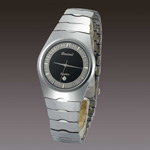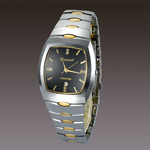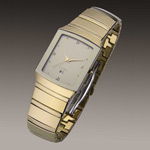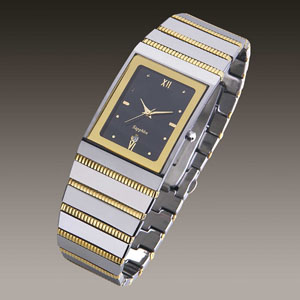Tungsten Watches Facts
What is watch?
A watch is a small clock, typically worn either on the wrist or attached on a chain and carried in a pocket; wristwatches, however, are the most common type of watch used today. Watches evolved in the 17th century from spring powered clocks, which appeared in the 15th century. The first watches were strictly mechanical. As technology progressed, the mechanisms used to measure time have, in some cases, been replaced by use of quartz vibrations or electromagnetic pulses. The first digital electronic watch was developed in 1970.
Before wrist watches became popular in the 1920s, most watches were pocket watches, which often had covers and were carried in a pocket and attached to a watch chain or watch fob. In the early 1900s, the wristwatch, originally called a Wristlet, was reserved for women and considered more of a passing fad than a serious timepiece. Men, who carried pocket watches, were quoted as saying they would "sooner wear a skirt as wear a wristwatch". This changed in World War I, when soldiers on the battlefield found pocket watches to be impractical and attached their watches to their wrist by a cupped leather strap. It is also believed that Girard-Perregaux equipped the German Imperial Navy with wristwatches in a similar fashion as early as the 1880s, to be used while synchronizing naval attacks and firing artillery.
Most inexpensive and medium-priced watches used mainly for timekeeping are electronic watches with quartz movements. Expensive collectible watches, valued more for their workmanship and aesthetic appeal than for simple timekeeping, often have purely mechanical movements and are powered by springs, even though mechanical movements are less accurate than more affordable quartz movements. In addition to the time, modern watches often display the day, date, month and year, and electronic watches may have many other functions. Watches that provide additional time-related features such as timers, chronographs and alarm functions are not uncommon. Some modern designs even go as far as using GPS technology or heart-rate monitoring capabilities.
Tungsten Watches Facts
Tungsten watches facts are the most wear-resistant watches available on the planet.
Tungsten is about 10 times harder than 18K Gold, 5 times harder than tool steel, and 4 times harder than titanium. Tungsten measures between 8 and 9 on the Mohs hardness scale. (Diamonds are a 10 - the highest.)
Due to their extreme hardness, Tungsten watches facts will hold their shape and shine longer than any watches on the market.
Tungsten watches facts have been referred to as "Permanently Polished Watches."
Tungsten watches will NOT bend.
Each tungsten watches is individually hand-crafted using assorted diamond abrasives and polycrystalline diamond tooling.
Fowling are the pictures about tungsten watches facts:
 |
 |
 |
 |
| Tungsten Watches Facts1 | Tungsten Watches Facts2 | Tungsten Watches Facts3 | Tungsten Watches Facts4 |
If you have any interest in tungsten watches facts, please feel free to contact us by email: sales@chinatungsten.com, sales@xiamentungsten.com or by telephone: +86 592 5129696.






 sales@chinatungsten.com
sales@chinatungsten.com